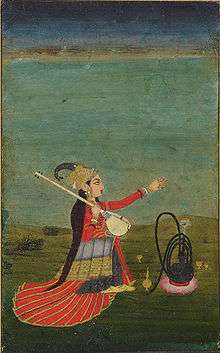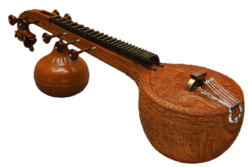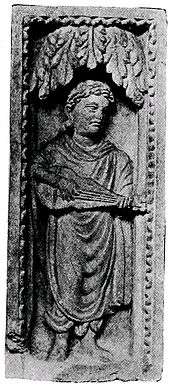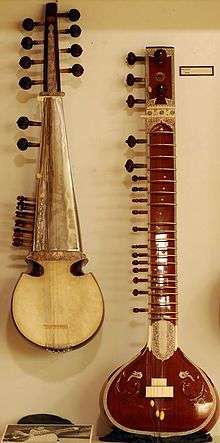Veena
|
Saraswati Veena | |
| String instrument | |
|---|---|
| Classification | |
| Related instruments | |
The Veena (Sanskrit: वीणा) is a plucked stringed instrument originating in ancient India, used mainly in Carnatic classical music and Hindustani classical music. The name is used for several instruments belonging to different families, mainly the Rudra Veena (a zither) and the Saraswati veena (a necked bowl lute) but also to other types of plucked string instruments (Mohan veena, ancient veena etc.).
The earliest Veena was an instrument of the harp type whose type survives in the Burmese harp, whereas in the last centuries and nowadays, the word has tended to be applied to instruments of the lute type or even, recently, to certain kinds of guitars developed in India. The more popular sitar is believed to have been derived from a type of Veena which was modified by a Mughal court musician to conform with the tastes of his Persian patrons. A person who plays a Veena is called a vainika.

Etymology and history
The Sanskrit word veena (वीणा) (sometimes transliterated as vina) as a generic term for all kinds of string instruments, just as the Tamil word yaaḻ (யாழ்) (often written yaazh or yaal). Veena is attested already in the Rigveda has designated in the course of Indian history a variety of instruments of various types and also finds in the list of Musical instruments used by Tamil people out in Tirumurai[1][2] dated 6th to 11th century. In the last centuries and today the instruments designated under the designation veena of which there are several kinds, have tended to be mostly instruments of the lute or cithar type, and recently the word was even applied to modified Western guitars. But the early veenas could be plucked string instruments of any type.
The early Gupta veena: depiction and playing technique
One of the early veenas used in India from early times, until the Gupta period and later—this is probably the instrument referred to as veena in a chapter of the Nāṭyaśāstra (नाट्यशास्त्र:) dealing with instrumental music—was an instrument of the harp type and more precisely of the arched harp. It was played with the strings being kept parallel to the body of the player, with both hands plucking the strings, as shown on Samudragupta's gold coins.[3][4] It is not possible to tell exactly the number of strings of the instrument on the coin, but descriptions in early literary sources of an ancient instrument called thesaptatantree veena (7-string veena) seem to coincide generally with the type of instrument represented on the coin.
Classification
Veena can be broadly classified into several different types
With frets
- Rudra veena, plucked string instrument used in Hindustani music
- Saraswati veena, plucked string instrument used in Carnatic music
Fretless
- Vichitra veena, plucked string instrument used in Hindustani music
- Chitra veena or gottuvadhyam, plucked string instrument used in Carnatic music
Other
- Yazh, or Shatatantri veena
- Saptatantri veena
See also
- Pandura
- Surbahar
- Rudra veena
- Saraswati veena
- Chitra veena
- Vichitra veena
- Ranjan veena
- Triveni veena
- Sarod
- Sitar
- Sursingar
- Tambouras
- Tambura
Notes
- ↑ Veenai - Ancient music instruments mentioned in thirumurai -
- ↑ Panniru Thirumurai - Shaiva Literature
- ↑ Catalog and description of the gold coins minted during Samudragupta's reign on the Coin India site (Web page)
- ↑ The right hand plucks the strings on the side of the instrument which is closer to the body while the left hand plucks the strings on the other side of the instrument. This is precisely the reverse of the way the saung is held. It is also possible the king was playing left handed or that it is the representation on the coin which presents an inverted (mirror-like) view
External links
| Wikimedia Commons has media related to Veenas. |
- Mobarak Hossain Khan; Wakil Ahmed; Momen Chowdhury (2012), "Musical Instruments", in Sirajul Islam; Ahmed A. Jamal, Banglapedia: National Encyclopedia of Bangladesh (Second ed.), Asiatic Society of Bangladesh


